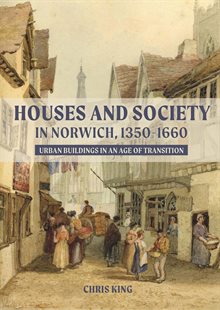Project goals
The aim of this research was to bring together the study of standing buildings and excavated urban tenements together for the first time, to investigate the changing use and meaning of domestic space in the city at different social levels, during a period of major social and economic change and transition.
The so-called "age of transition" witnessed profound social and economic changes and religious and political upheavals, which Norwich, as a major provincial capital, experienced with particular force and intensity; domestic life was also transformed. The project examines the twin themes of continuity and change in the material world and the role of the domestic sphere in the expression and negotiation of shifting power relationships, economic structures and social identities in the medieval and early modern city.
Project overview
Norwich was the largest and wealthiest city outside London in late medieval and early modern England, as a major centre for trade with the Low Countries and with a booming textile industry. It was only eclipsed by the Atlantic seaports and the northern industrial cities in the middle decades of the 18th century.
Today, it has one of the richest archaeological records for urban houses and households in the country, including over 200 surviving domestic buildings and many large-scale urban excavations undertaken by the Norwich Survey in the 1970s as well as more recent commercial excavations.
Buildings in Norwich
One element of the research focused on the large courtyard houses which once belonged to the city’s great merchant families, who also dominated the civic government. In the medieval period, these houses contained a great hall, open to the roof with impressive decorative roof timbers and bay windows. These spaces were important signifiers of rank and status within the urban community, and were used for entertaining and feasting on a lavish scale during important civic occasions.
In the period of religious and political upheaval following the 16th-century Reformation, many merchants retained their great halls as symbols of family honour and stability. However, others constructed new types of house without an open hall, and instead had suites of reception rooms ranged on the first floor of their houses, where they could entertain honoured guests more privately.
At a lower social level, combining the standing building and excavated evidence provides new insights into the use of domestic space by the middling and lower orders, and a new chronology of building development across the city. In Norwich, the ‘great rebuilding’ occurred significantly earlier than it did in better-known rural areas. Many houses were being rebuilt with brick chimneystacks, two stories and solid construction from the late 15th century onwards.
The archaeological evidence also shows that, as the urban population expanded dramatically from the late 16th century with the rise of the city’s cloth industry, houses were divided up, courtyards were infilled with poorly-built cottages, and living conditions deteriorated with yards, privies and wells shared between many households. Eventually these crowded tenements became the notorious ‘yards’, most of which were demolished by slum clearance programmes in the early decades of the 20th century.
Project outcomes
Several journal articles and book chapters have been published arising from this research, and a monograph is to be published by Boydell and Brewer in 2020.
Future research is planned which will further explore how we can integrate standing building evidence, archaeological excavations, museum collections and documentary sources to develop more holistic, sophisticated reconstructions of the appearance and use of domestic interiors in medieval and post-medieval urban houses.
Project team
Christopher King
Research partners
Arts and Humanity Research Council (AHRC)
University of Reading
Publications

Book cover for Houses and Society in Norwich, 1350-1660: Urban Buildings in an Age of Transition
King, C. 2020. Houses and Society in Norwich, 1350-1660: Urban Buildings in an Age of Transition. Boydell and Brewer. ISBN 9781783275540.
King, C., 2016. Domestic buildings: understanding houses and society. In: Gaimster, D., Hamling, T. and Richardson, C., eds., The Routledge Handbook of Material Culture in Early Modern Europe Routledge. 111-125.
King, C., 2015. Private lives and public power: Norwich merchants' houses between the 14th and 16th centuries. In: Heslop, T. A. and Lunnon, H. E., eds., Norwich: Medieval and Early Modern Art, Architecture and Archaeology: The British Archaeological Association Conference Transactions XXXVIII Maney Publishing. 341-358.
King, C. 2010. ‘‘Closure’ and the urban great rebuilding in early modern Norwich’, Post-Medieval Archaeology 44 (1): 54-80.
King, C. 2009. ‘The interpretation of urban buildings: power, memory and appropriation in Norwich merchants’ houses, c.1400-1660’, World Archaeology 41 (3): 471-88.